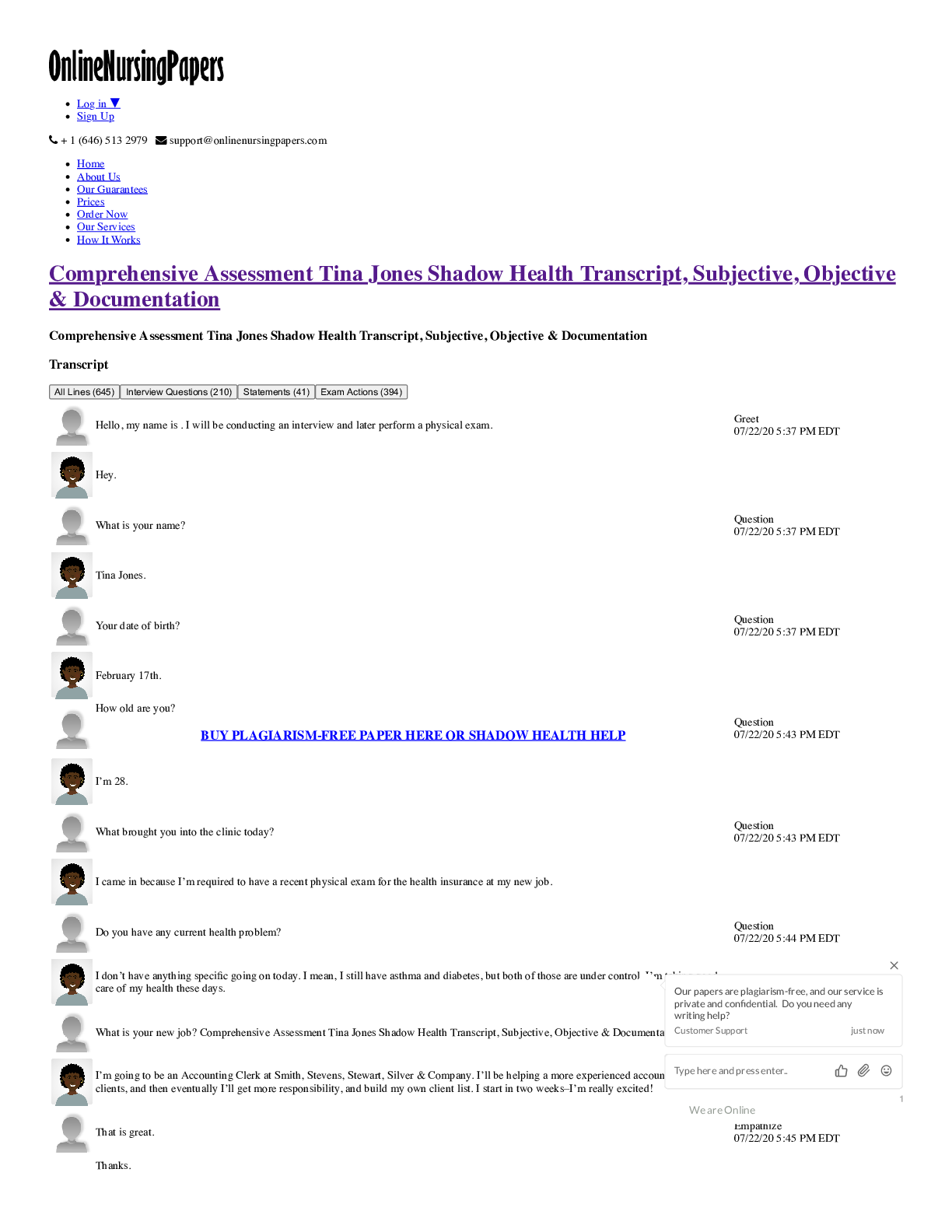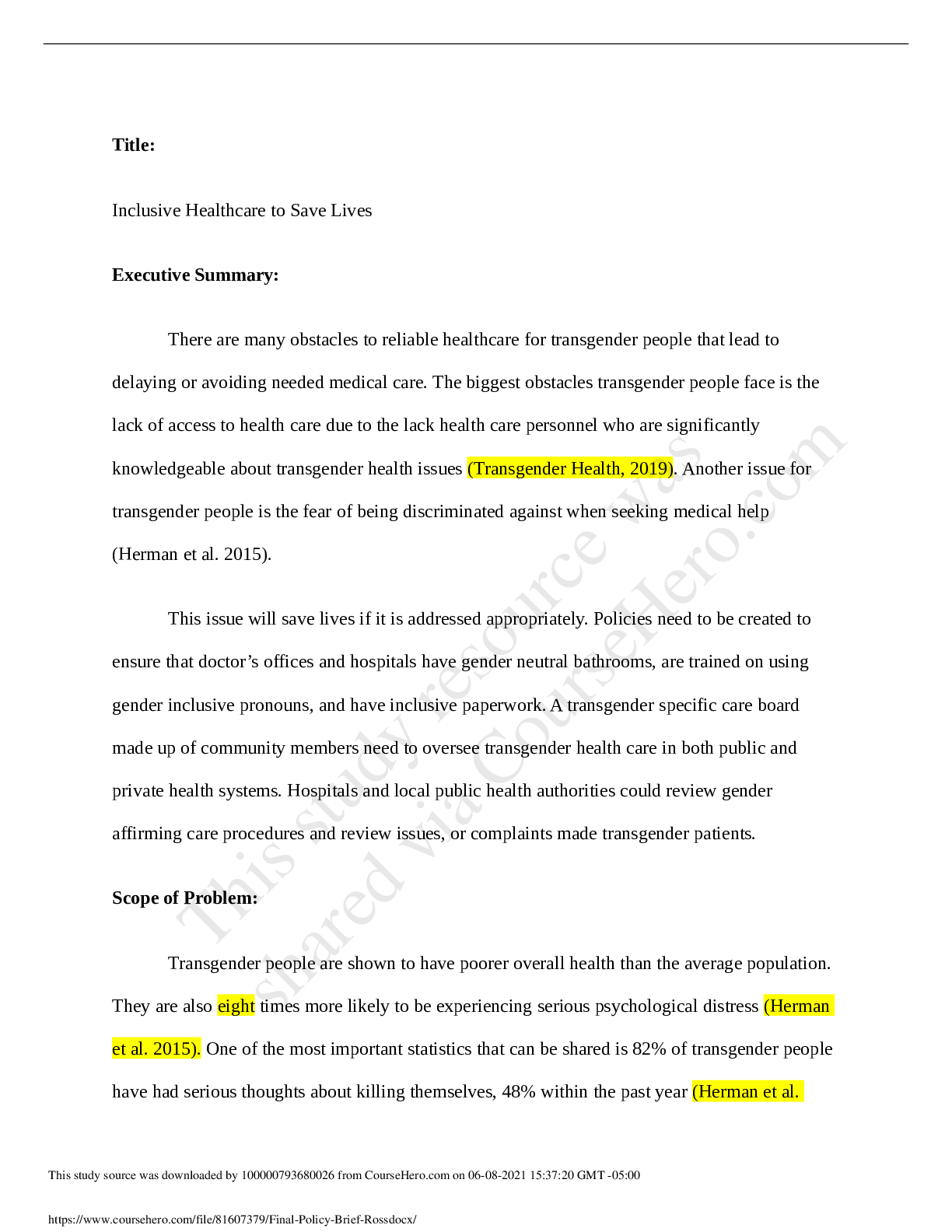*NURSING > Research Paper > NURS-FPX4900_LangfordBreanna_Assessment2-Assessing the Problem: Quality, Safety, and Cost Considerat (All)
NURS-FPX4900_LangfordBreanna_Assessment2-Assessing the Problem: Quality, Safety, and Cost Considerations
Document Content and Description Below
Assessing the Problem: Quality, Safety, and Cost Considerations Breanna Langford Capella University NURS-FPX4900 Anne Lara May 7, 20212 Impact on the Quality of Care, Patient Safety, and Cost of... Care 34.1 million American adults suffer from Diabetes Mellitus (DM) (Centers for Disease Control and Prevention [CDC], 2020), the seventh leading cause of death, yet over half of them have never received adequate DM self-management education and support (Healthy People 2030, 2020). Those suffering from DM have an increased risk for microvascular and macrovascular complications that lead to a decreased quality of life. The adherence to selfmanagement behaviors is critical to prevent or delay costly complications. In this assessment, the author will assess the effect of DM on the quality of care, patient safety, and costs to the system and diabetic population, including Veronica, an individual newly diagnosed with DM type two. As a registered nurse in the Emergency Department, it is common to see individuals admitted with a new diagnosis of DM. Within just a few months, some of those same patients are readmitted with DM-associated complications. DM is a demanding chronic disease, and it requires the diabetic individual, such as Veronica, to make frequent daily decisions to manage it. Veronica expresses concerns pertaining to the quality of her life. She stated that during her initial hospitalization, she was overwhelmed by receiving more information than she could retain and is unsure of how to incorporate it into her daily life. She feels the necessary demands of having to frequently check her blood glucose disrupt her social life because she’s embarrassed by having to check while she is spending time with friends or family. She feels she’s a burden when trying to eat out with them because she has to strategically plan what and when she eats. She is also overwhelmed by the necessity of taking three medications in addition to insulin. The medications often make her nauseous or give her an upset stomach. She also voices fear of the possibility of complications that may develop secondary to her DM. Diabetic patients often suffer from feelings of fear, anxiety, depression, and hopelessness (Sachar et al., 2019). In turn, poor mental3 health negatively affects a person’s ability to self-manage DM, and self-management is the cornerstone of diabetes care. Just as DM can affect one’s quality of life, one’s quality of life (choices) can affect their diabetes. When a diabetic individual doesn’t manage their disease, they are susceptible to complications requiring hospitalization. Diabetics have a threefold greater chance of hospitalization compared to those without DM (Bansal et al., 2018). The primary causes of hospitalization include chronic and end-stage kidney disease, ischemic heart disease, stroke, infection requiring lower-extremity amputation, hyperglycemic crisis, and vision disability, including blindness (CDC, 2020). People suffering from DM face higher admission and readmission rates, extended lengths of hospital stay. Thirty-day hospital readmission is a highpriority health care quality measure and target for cost reduction. Studies report that the 30-day readmission rate for hospitalized patients with DM is nearly double than those without DM (Bansal et al., 2018). Consequently, the cost of care for diabetic patients imposes a substantial burden on the economy. Over five years, the total estimated annual cost of treating individuals diagnosed with DM has increased by 26% and accounts for 24% ($414 billion) of all health care spending in the country (American Diabetes Association [ADA], 2018). Individuals diagnosed with DM, on average, have medical expenditures 2.3 times higher than those without DM and incur an average annual medical expenditure of $16,750, and about $9,600 of it is attributed to DM (ADA, 2018). Patient safety is a major concern for the diabetic population due to the pathological processes of DM that can cause peripheral nerve damage and peripheral arterial disease, which reduced blood flow to their extremities. This not only results in an increased risk of infection but [Show More]
Last updated: 2 years ago
Preview 1 out of 14 pages

Buy this document to get the full access instantly
Instant Download Access after purchase
Buy NowInstant download
We Accept:

Reviews( 0 )
$12.00
Can't find what you want? Try our AI powered Search
Document information
Connected school, study & course
About the document
Uploaded On
Jun 22, 2021
Number of pages
14
Written in
Additional information
This document has been written for:
Uploaded
Jun 22, 2021
Downloads
0
Views
115













